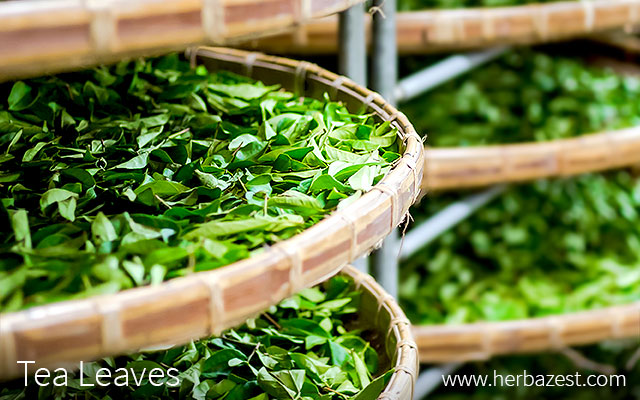The tea plant (Camellia sinensis), is only cultivated for its leaves. They are behind the lucrative tea market, which is estimated to be worth 44.3 billion US dollars by 2021. Tea leaves are grown in over 40 countries, with China, India, Kenya, and Sri Lanka being responsible for 75% of the world's tea production. From planting and harvesting to processing and storing, fresh tea leaves require special care and careful handling to be able to offer their unique taste and aroma.
Tea Leaves' Appearance
All true teas come from the Camellia sinensis plant, which is an evergreen shrub cultivated in the tropical and subtropical climates around the world. The waxy tea leaves are arranged in an alternating fashion, along large branches that spring from a thick stem. They are bright to dark green (depending on their stage of maturity) narrow and slightly pointy, with serrated borders, ranging between 1.6 - 2.8 inches (4 - 7 cm) in length.
Harvesting Tea Leaves
Tea is typically harvested by hand around the world, because it is the best way to ensure that the delicate tea leaves do not suffer any damage. Machine harvesting is practiced as well, but it often bruises and crushes the leaves, which is believed to affect their flavor.
During each harvest, also called a “flush”, only the top bud and two new, fresh tea leaves are picked. There are typically four flushes during the harvesting season, but the leaves collected during the first flush are said to give the most flavorful tea.
Processing Tea Leaves
Fresh tea leaves need to be processed as soon as they are picked, otherwise they start to wilt. The first step, called withering, promotes the release of the leaves' proteins and allows them to lose their moisture. The next step of cutting the leaves involves one of two methods: CTC (cut, tear, curl), which is used to make tea bags, and the orthodox method, which is used to make various sizes and styles of loose leaf tea.
The third step determines the different types of tea that will be obtained as the final product. If tea leaves are left to oxidize, they will turn from green to brown, becoming black tea, like Assam, Darjeeling and Ceylon tea. To obtain green tea, the oxidation is stopped by dry-heating or steaming the leaves, which allows them to retain their greenness. Oolong, for example, is a type of tea that is only partially oxidized and therefore, the color of its leaves is brownish-green. In this case, the tea leaves are rolled and shaped, either by hand or by a machine, and then dried.
The health benefits of tea vary depending on the way fresh tea leaves are processed.
How to Preserve Tea Leaves
Tea leaves cannot be stored fresh, so they have to be fully processed first. The main goal in storing dry tea leaves is preserving their freshness and flavor, and there are several factors that can negatively affect that. For example, moisture, which tea leaves easily absorb from the air, not only modifies their taste and freshness, but it also increases the risk of mold formation. Heat and large amounts of light can also degrade whole leaf tea, reducing its flavor and also its benefits.
The most optimal way for preserving dry tea leaves is storing them in a dark, airtight container away from heat, humidity, and light. These conditions will ensure that the leaves retain their taste and aroma for the duration of their shelf-life, which is quite long for most loose leaf teas. For example, green and Oolong teas should be used within eight to 14 months from its production, while a black tea's shelf life falls between 14 - 18 months.
Sources
- The Green Tea Book: China's Fountain of Youth
- The Story of Tea: A Cultural History and Drinking Guide
- The Tea Book, pp. 66-68




